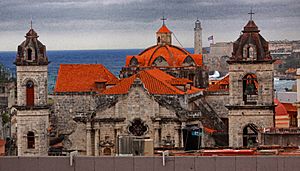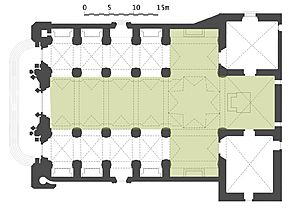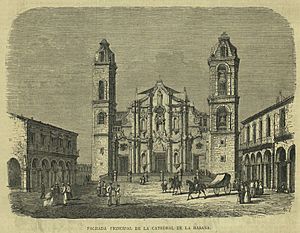Havana Cathedral facts for kids
Quick facts for kids Catedral de San Cristóbal |
|
|---|---|
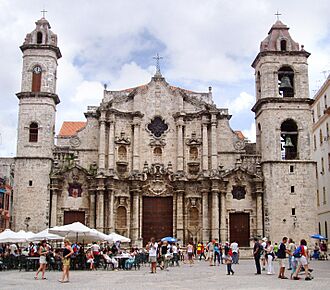
Catedral de San Cristóbal
|
|
| General information | |
| Type | Religious |
| Architectural style | Baroque |
| Address | 156 Empedrado |
| Town or city | Havana |
| Country | Cuba |
| Groundbreaking | 1748 |
| Completed | 1777 |
| Technical details | |
| Structural system | Load bearing |
| Material | Coral stone |
| Floor count | 1 |
The Havana Cathedral (also known as Catedral de la Purísima Concepción de María) is a famous Catholic church in Havana, Cuba. It is one of eleven Catholic cathedrals on the island. You can find it in the Plaza de la Catedral in Old Havana. This large church is the main church for the Roman Catholic Archdiocese of San Cristóbal de la Habana.
The cathedral is well-known because the remains of Christopher Columbus were kept here for over 100 years. They were moved to the cathedral in 1796 and stayed until 1898. The building itself was constructed between 1748 and 1777. It was officially opened in 1782.
Contents
History of the Havana Cathedral
The Society of Jesus, a large group of missionaries, wanted to build a church in Havana. After asking for a long time, they bought some land in the Plaza. In 1727, plans for a church, a convent, and a school were approved. The project started to take shape.
The area where the cathedral stands was once a swamp. This swamp was drained and used as a naval dockyard before the church was built. The Jesuits began building the cathedral in 1748. They built it on the site of an older church. The construction finished in 1777. This was after King Charles III of Spain had ordered the Jesuits to leave the island in 1767.
Christopher Columbus's Remains
In 1796, an important event happened. After a peace treaty was signed, Spain gave most of Hispaniola to France. Because of this, the remains of Christopher Columbus were moved. They were brought to the Havana Cathedral and placed in the Altar of the Gospel. His gravestone had a special message. It read: Oh Remains and Image of Great Columbus, Be Preserved One Thousand Years in the Funerary Urn.
However, Columbus's remains did not stay there forever. In 1898, after the Cuban War of Independence, they were returned to Spain. They are now in the Seville Cathedral.
Changes Over Time
In the early 1800s, the cathedral's look changed. The original Baroque altars were replaced with new ones in a Neoclassical style. Bishop Espada, who loved Neoclassicism, encouraged these changes. The old wooden ceilings were also covered with plaster.
Cathedral Architecture
The Havana Cathedral is a great example of Baroque architecture. Its front has bell towers that are not exactly the same on both sides. The details on the front look similar to those on the San Carlos and San Ambrosio Seminary. This seminary is part of the same church complex.
You can see fossilized sea creatures and plants in the stone walls. This is because the cathedral, like many buildings in Havana, is built from blocks of coral. The church has a main central area called a nave. It also has two side aisles and eight smaller chapels on the sides.
Large stone arches support the central nave. These are called flying arches. They are located outside the cathedral, above the side aisles. You cannot see these flying arches, the dome over the transept, or the orange roof tiles from the main square. The central nave is about fifteen meters wide. The overall shape of the building forms a Latin cross.
Artworks and Treasures
The cathedral is home to many beautiful artworks. These include sculptures, paintings, and frescoes. You can find a statue of Apolinar Serrano inside. He was a Spanish bishop of Havana and is buried in the cathedral.
Some of the side chapels have copies of famous paintings. These copies are of works by well-known artists like Rubens and Murillo. There is also a sculpture of Saint Christopher, who is the Patron Saint of Havana. This sculpture was made in 1632 by Martín de Andújar Cantos in Seville, Spain.
Above the main altar, there are three old frescoes. These were painted by the Italian artist it:Giuseppe Perovani. He was a Neoclassical artist. Bishop Juan José Díaz de Espada y Fernánez de Landa asked him to paint three scenes. These scenes show The Delivery of the Keys, The Last Supper, and The Ascension.
You can also see a canvas painting of the Virgin of the Immaculate Conception. She is the Patroness of the cathedral. Perovani also painted the canvas for the orange chapel, which shows the Virgin of Loreto. This painting was blessed in 1755.
On the altar, there are sculptures and gold artworks. These were made in Rome in the early 1800s. On the walls, you can see oil paintings by the French artist Jean Baptiste Vermay. He was the founder and first director of the Academy of Painting and Drawing of San Alejandro. He also created the interior works of the El Templete, which is in the original part of the city.
The Havana Cathedral is located in Old Havana. This entire area was named a World Heritage Site by UNESCO in 1982.
Gallery
See also
 In Spanish: Catedral de La Habana para niños
In Spanish: Catedral de La Habana para niños
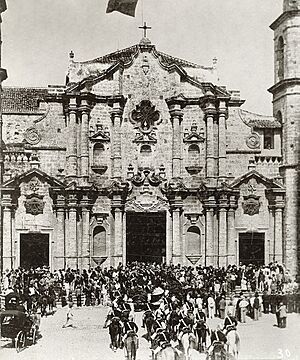
- National Basilica Sanctuary of the Charity del Cobre
- List of Jesuit sites


